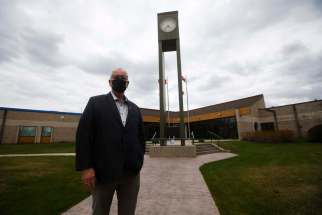Solid effort at IG Field but no win-win
Read this article for free:
or
Already have an account? Log in here »
To continue reading, please subscribe:
Monthly Digital Subscription
$0 for the first 4 weeks*
- Enjoy unlimited reading on winnipegfreepress.com
- Read the E-Edition, our digital replica newspaper
- Access News Break, our award-winning app
- Play interactive puzzles
*No charge for 4 weeks then price increases to the regular rate of $19.00 plus GST every four weeks. Offer available to new and qualified returning subscribers only. Cancel any time.
Monthly Digital Subscription
$4.75/week*
- Enjoy unlimited reading on winnipegfreepress.com
- Read the E-Edition, our digital replica newspaper
- Access News Break, our award-winning app
- Play interactive puzzles
*Billed as $19 plus GST every four weeks. Cancel any time.
To continue reading, please subscribe:
Add Free Press access to your Brandon Sun subscription for only an additional
$1 for the first 4 weeks*
*Your next subscription payment will increase by $1.00 and you will be charged $16.99 plus GST for four weeks. After four weeks, your payment will increase to $23.99 plus GST every four weeks.
Read unlimited articles for free today:
or
Already have an account? Log in here »
Hey there, time traveller!
This article was published 18/05/2021 (1665 days ago), so information in it may no longer be current.
A proposed new financing deal for IG Field won’t have the Winnipeg Blue Bombers repay tens of millions in unpaid loans to the provincial government.
However, it will protect taxpayers from further exposure and allow the CFL franchise to become a self-sustaining entity.
It is the best anybody could hope for at this point.
The proposal announced last week is a convoluted pact between the Bombers, province, City of Winnipeg and University of Manitoba. It’s less complex than the rat nest the former NDP government concocted for the original stadium deal, but it does have a lot of moving parts.
It solves a longstanding problem: how to pay for the south Winnipeg stadium’s future capital upgrades without going back to taxpayers for another pound of flesh.
One of the many flaws in the original deal, which included two provincial government loans that will never be repaid in full, is no provision was made to finance ongoing building maintenance.
After the NDP was defeated in 2016, the Progressive Conservative government had two choices: continue to demand the Bombers make regular loan payments (and have the province pay for future stadium capital costs) or allow the team to keep its revenues to service the building.
One of the many flaws in the original deal, which included two provincial government loans that will never be repaid in full, is no provision was made to finance ongoing building maintenance.
The Pallister government chose the latter. A wise choice.
The new deal will cost taxpayers an additional $10 million: a one-time contribution to a stadium capital fund. The province is also taking over a $35-million loan to fund repairs and a lawsuit tied to alleged building deficiencies. Both are tough pills for taxpayers to swallow, but it does leave government in the clear going forward.
The agreement still has to be approved by the City of Winnipeg (one of three partners in Triple B Stadium Inc., which owns the building on the U of M campus).
Council is expected to back it, especially since it would free city hall from future involvement in Triple B. Under the deal, the city and the U of M would no longer be partners in the organization; the Winnipeg Football Club would become the sole member of Triple B.
The only major change the city would have to make is a bylaw amendment to allow the Bombers to use the entertainment tax and facility fees charged on tickets as general revenue (which are now dedicated to loan repayment).
According to details from Manitoba Finance, there is a formula that will determine how future CFL team profits are allocated. The first $1 million would go into the stadium capital fund and the second $1 million would be transferred to the team’s operating reserve.
Any profits beyond that would also go to the capital fund until it is “fully funded.”
If there’s still profit left over, that money would go to the province.
That’s where the new agreement gets complicated.
There has to be enough money in the fund to cover major capital upgrades for the next five years and 80 per cent of anticipated capital costs over eight years. “Anticipated” capital costs (such as roof upgrades) are fluid; they change over time.
How a fully funded capital reserve is calculated is important because it would determine when, or if, the Bombers pay the province.
The team’s $85-million loan from the provincial government (it has paid about $6 million thus far) has essentially been written off. The accountants call it a “loan loss provision.” There’s no expectation it will be repaid.
A second $75-million loan that was part of the original stadium deal, financed through property taxes at the former stadium site at Polo Park, remains intact. It’s unlikely enough property taxes will ever be generated there to repay that loan in full. However, payments are required until 2038.
The new agreement does two things: ensures taxpayers won’t have to sink any more money into the stadium (beyond the $10-million contribution to the capital reserve), and gives the Bombers the best chance yet at becoming a self-sustaining organization, with its own building.
It’s about as good as it’s going to get.
tom.brodbeck@freepress.mb.ca

Tom has been covering Manitoba politics since the early 1990s and joined the Winnipeg Free Press news team in 2019.
Our newsroom depends on a growing audience of readers to power our journalism. If you are not a paid reader, please consider becoming a subscriber.
Our newsroom depends on its audience of readers to power our journalism. Thank you for your support.





